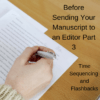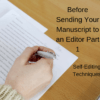You have worked long and hard to write your memoir. Memoir editing would be fine but you are ready to turn the computer off and receive the accolades you feel you deserve! You want to be finished.
Wouldn’t it be great to have “I’ve gotten my story out and that’s that with my memoir” be the same as “the story is ready to affect the reader”?
At some level, you are ready to move on, but, wait! is your memoir ready for its audience? Is what you have a penultimate draft rather than a ready-to-be-published manuscript? It may even be a very good draft but it’s probably not the finished manuscript you are hoping it is.
This is the time to engage memoir editing.
Every writer ought to engage an editor before moving a manuscript on to the public. When you think your writing is completed, you probably still need memoir editing. An editor will help you to identify any shortcomings in your memoir and help you make the decisions you must make to develop the story, its theme and its promise, to its maximum potential for all to appreciate. Memoir editing will help you assess the pacing and shaping of your story and help you tighten both.
In conclusion
The information in the posts below will help you with these tasks. After you’ve read the posts, come over to our memoir editing services pages and check out how The Memoir Network can help you to generate the best manuscript you are capable of.

Better Self-Editing: 3 Easy Techniques
In today’s post, we look deeply into 3 techniques for better self-editing—obviously there are many more but these three are a start for a short post.
I have been a memoir editor since 1990. In that time, I have worked with hundreds and perhaps thousands of memoir manuscripts.
A few manuscripts have come to me requiring only slight tweaking. The texts are clear, coherent and concise. They are nearly ready for publication. Their authors have created an interesting and well-crafted piece of writing. They have clearly mastered better self-editing.
Too many other manuscripts, however, have come to me at a stage that reflects tired or exasperated writers. They seem to be saying I’m-ready-to-have-this-writing-over-with!
The challenge of self-editing
[Free Membership required to read more. See below. ]
We'd love to have you access this content. It's in our members-only area, but you're in luck: becoming a member is easy and it's free.
Already a Member?
Not a Member Yet?

The Difference Between Proofreading and Editing
After having written a good portion of their memoir, writers will sometimes begin to wonder if it is time to hire a writing professional to work with them to get the manuscript ready to go out into the world. At this stage, they may ask, “What’s the difference between proofreading and editing? And, how do I know which one I need?”
What Is Proofreading?
Proofreading is the more technical, nutsy-boltsy end of editing. Someone who is an editor will often also undertake to proofread a manuscript. Proofreading is concerned with mechanics: spelling, punctuation, noun/verb agreement, other grammar problems, consistency (abbreviations, digits vs. numbers that are spelled out as words, etc.), obvious breaks from styling (inconsistencies in fonts, line spacing, spacing between words, and margins), and factual errors (dates, place names, historical facts).
Obviously, proofreading requires a solid foundation in grammar, vocabulary, and general knowledge. It requires an eye for detail. Proofreaders refer often to the following in hard copy or on the internet: a dictionary, an atlas, and an encyclopedia.
What Exactly Is the Difference Between Proofreading and Editing ?
[Free Membership required to read more. See below. ]We'd love to have you access this content. It's in our members-only area, but you're in luck: becoming a member is easy and it's free.
Already a Member?
Not a Member Yet?

Before Sending a Manuscript To An Editor / Part 3: Time Sequencing and Flashbacks
Note from the Editor: This third installment of Before Sending a Manuscript to an Editor series offers basic editing tips around time sequencing and flashbacks. For Part 1: Self-Editing Techniques Click here. For Part 2: Use of Time Click here.
A writer can effect these tips to bring a manuscript to a higher level of finish before sending the piece off to a professional editor. In this section, I write about use of time: specifically, cause and effect time sequencing and flashbacks.
Cause and Effect
In the previous post on the use of time, I wrote about the cause-and-effect sequence as a sub-aspect of proper chronology.
Before I get to the cause-and-effect sequence which is an absolutely necessary styling element to understand, I need to review an essential element of memoir writing (as of fiction): the suspension of disbelief.
A writer can effect these tips to bring a manuscript to a higher level of finish before sending the piece off to a professional editor. In this section, I write about time sequencing: specifically, cause and effect sequencing and the flashback. [Free Membership required to read more. See below. ]
We'd love to have you access this content. It's in our members-only area, but you're in luck: becoming a member is easy and it's free.
Already a Member?
Not a Member Yet?

Before Sending a Manuscript To An Editor / Part 1: Self-Editing Techniques
Note from the Editor: This first installment of Before Sending a Manuscript to an Editor series offers basic editing tips around self-editing techniques. For Part 2 Use of Time Click here. For Part 3 Time Sequencing and Flashbacks Click here
Self-Editing Techniques and Tips
I have been a memoir and fiction editor since 1990. In that time, I have worked with hundreds of manuscripts.
Some have come to me requiring only slight tweaking. The texts are nearly ready for publication. The authors have created an interesting and well-crafted piece of writing.
Too many other manuscripts, however, have come at a stage that reflects the I’m-ready-to-have-this-writing-over-with-finally stance of tired writers. Writing can be a long and tedious task after the initial rush of creativity and enthusiasm. Once the glow fades, Pegasus drops the enchanted writer from the skies and—horrors—the writer has to mount a pack mule to trudge the slopes of rewriting. (“But, I want to do inspired writing,” the writer bemoans, “not pick-and-shovel work!”)
Check this before sending a manuscript to an editor.
[Free Membership required to read more. See below. ]
We'd love to have you access this content. It's in our members-only area, but you're in luck: becoming a member is easy and it's free.
Already a Member?
Not a Member Yet?

Why You Should Work With a Coach or an Editor Early in the Process
Clients will often come to me after having done a considerable amount of writing. Sometimes I will receive 200- and 300-page manuscripts. Among them are manuscripts that are really at the editing stage, but… There are too many that are still—in spite of their polished look on the page—in an early stage of development.

More Editing You Can Execute For Yourself.
This post contains more useful information on how you can edit your own work before sending it to a professional editor. There is much you can do more effectively to save on fees.
